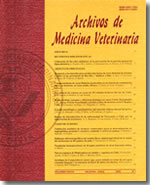Productivity, intake and biological efficiency in New Zealand Friesian and F1 (Jersey-New Zealand Friesian) cows calved during late winter in the Xth Region, Chile
Main Article Content
Abstract
At Oromo Experimental Station, University of Chile, Xth Region, Chile (41º08 S; 73º09 W), 47 primiparous cows, 23 New Zealand Friesian (NZF) and 24 Jersey-NZF (F1), were used to estimate productivity, intake and biological efficiency, under grazing conditions. The information was obtained in 3 experimental periods (21 days each one), at which the cows were at 66, 126 and 220 days of lactation, respectively. The animals were weighed daily in order to estimate mean live weight (LW) and live weight changes. Milk production (MP) was measured 9 times each period, and weekly, a sample of milk was used to measure fat and protein content. Pasture dry matter intake (PDMI) was estimated relating metabolizable energy requirements (MER) and pasture ME content (PMEC); then PDMI = MER/PMEC. MER values were estimated by means of the equations described by AFRC (1993). Pasture was sampled at each period and PMEC, gross energy and crude protein content were measured. A factorial experimental design, with repeated measures, was used for statistical analysis. The MP was similar, with 18.2 and 17.6 kg/cow in F1 and NZF, respectively (P = 0.3581). F1 had 45.8 g/kg fat content, exceeding NZF in an 8.3% (P = 0.0094). Also F1 was better than NZF (P ≤ 0.0156) in fat (12.1%) and protein production (6.6%); energetic content per kg of milk (4.9%); energetic content in total daily MP (8.3%); 4% fat corrected MP (8.3%) and solids corrected MP (8.3%). LW of NZF was 435.6 kg/cow, being 45 kg higher than F1 (P = 0.0001). In terms of productions per LW units, differences between both strains were highly significant (P = 0,0001), favoring F1 cows. The largest differences were found in fat production (24.6%) and 4% fat corrected MP (20.5%). PDMI values were not significantly different (P = 0.1642). However, if the values are expressed in relation to 100 kg of LW, F1 tended to have a higher pasture consumption (P = 0.0615). Milk and solids production differences per unit of PDMI were highly significant (P≤0.0284), favoring F1. The highest superiority was obtained in fat production (17,4%); in this case F1 reached a value of 63.88 g/kg of PDMI. The relationship between protein production and crude protein intake had values of 32.70 and 29.33% (P = 0.0003), in F1 and NZF, respectively. Net energy of daily MP in F1 was 37.13% of the metabolizable energy intake; increasing to 41.38% if a correction by the use of corporal reserves was considered. These percentages were lower (P ≤ 0.0002) in NZF. It was concluded that due to higher milk solid production, lower LW, and a better crude protein and metabolizable energy utilization, F1 showed a greater biological efficiency than NZF. The aforementioned abilities confer crossbred cows comparative advantages in systems where production and contents of milk solids are rewarded.

